While concrete is a strong material, natural elements can damage it over time leaving structural integrity of your structure at risk. This is one of the reasons you should periodically maintain and get it checked by specialists. Leaving damaged concrete as it is can turn a small problem into an expensive one while endangering the lives of everyone inside the building. To ensure that you intercept any issues with your concrete before they become worse, here are some signs that you should be on the lookout for.
Cracks
This is an obvious sign of concrete damage which can be caused by a number of factors – natural and man-made. However, cracks can also indicate structural damage, and therefore, must not be treated lightly. Depending on the fault, these can be hairline cracks, settlement cracks, or structural cracks. It is important to note that cracks can lead to structural damage by creating an opening point for moisture to get in and start damaging the steel.
Crumbling
If you notice that parts of the concrete are crumbling, chances are that it might be as a result of spalling. This typically results from mistakes that were made in the beginning, such as adding more water to the concrete mix than required. Only a certified professional can assess and repair this damage as it tends to spread quite quickly throughout the structure.
Discoloration
Concrete has a few protective elements in the mix that will protect it from natural elements but as time passes, the effectiveness of these elements goes down. As a result, you may observe rusting, discoloration, and darkening of certain parts. If you see a change in color, it is a tell-tale sign of concrete damage.
Water Pooling
Water plays a very complicated role in concrete structures. While it provides them with strength in the beginning, during heavy rains, it can also lead to structural faults in concrete walls. Water pooling, both above and beneath a concrete surface can also result in sinking. When you add stress due to other natural elements, it can lead to cracks. This is also true during the initial phase of construction when the water dries too quickly due to evaporation, resulting in moisture getting trapped below the surface.
Uneven Surfaces
If the area beneath the concrete has not been prepared properly before adding concrete, it can make the entire structure unstable. Overtime, it can weaken the structure and lead to other faults like cracks and uneven surfaces. This also happens when a contractor hasn’t prepared the soil before adding concrete leading to debris getting caught in certain spots. Tree roots beneath the surface can also lead to concrete damage if left unchecked.
Pests
If you noticed insects or animals borrowing a hole in your concrete structure, you may want to get it checked by a professional right away. Certain pests can dig beneath the surface causing the concrete to sink. If there is water running through these holes at the same time, the slab will eventually lose its strength and develop signs of damage.
Exposed Steel Beams
While this may not be an obvious sign of concrete damage, you should still get it checked right away by a professional. When cracks in concrete slabs grow to the point that steel beams get exposed, it opens the doors to structural integrity faults. When exposed to air and moisture, corrosion will start weakening the entire structure from within. This will eventually lead to the structure collapsing if left unchecked, endangering the lives of inhabitants.
At Turnbull Masonry, we offer many services including brick and concrete repair, tuckpointing, parging, chimney repair, and more in the Toronto area. If you have noticed any of the above signs with your concrete walls, get in touch with our experts right away. We will devise an exit strategy and help you repair the damage at reasonable costs with a guarantee of best-in-class service. To get your quote, contact our amazing team today!

